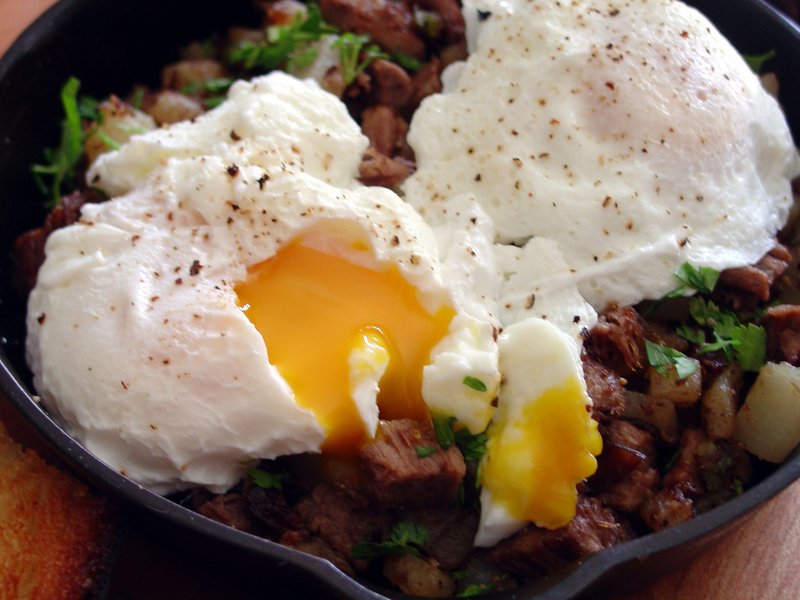One of the Christmas presents I’ve looked forward to every year since childhood doesn’t come with wrapping paper or ribbon. It doesn’t even arrive on Christmas Eve or morning. And you’ll never find it under the tree or tucked into a stocking hung by the chimney.
You’ll find this gift, in fact, in your refrigerator the morning after Christmas Day. I’m talking, of course, about the leftovers from your holiday roast.
It doesn’t matter whether the main course at Christmas dinner was roast beef, turkey, crown roast of pork, ham or even a duck or a goose. The meat you have left from your menu’s centerpiece is just waiting to become the featured ingredient in one of my all-time favorite home-cooked dishes: hash.
When I was a boy, come Dec. 26, my mother made the most delicious hash from our holiday roast. She’d trim away all the fat and gristle and then cut the meat into uniform cubes measuring about 1/3 inch across. (The word “hash,” by the way, comes to us from the French hache, meaning “chopped.”) Then, she’d cut up onions, bell peppers and potatoes into pieces of the same size and saute them in a large pan until the potatoes were nicely browned and crusty, before combining them with the meat and heating the whole mixture together.
Unlike short-order cooks do with American diner-style hash, which is usually compacted into cakes on a griddle, my mother kept her hash loose, scooping it onto serving plates in mounds that seemed especially impressive to my sisters, brother and me. I think this style of hash is especially good because it allows the warm, rich yolks of the cooked eggs you nestle on top of each serving to mingle with the meat and vegetables. (Just writing that last sentence makes my mouth water!)
Apart from the little bit of time and effort it takes you to cut up the ingredients, making the hash is remarkably easy compared to how delicious the results are. The only part of the recipe that might cause some people a little anxiety is poaching the eggs. But in the recipe, I include instructions for cooking the eggs in advance and reheating them quickly just before serving, as well as detailed tips that will lead to success even if you’ve never poached an egg before. And, if you prefer, you can always fry the eggs, or even scramble them, instead of poaching.
So, what’s keeping you from making yourself some wonderful hash for breakfast or lunch the morning after your Christmas or New Year’s feast, or any other time you cook a roast? I hope you’ll join me in recognizing the great holiday gift you’ll find, right in your refrigerator.
CLASSIC HASH WITH POACHED EGGS
Serves 6
Poached eggs:
1 or 2 large cage-free eggs per person
2 tablespoons white wine vinegar
Classic Hash:
6 tablespoons unsalted butter
About 1 1/2 pounds organic red or white rose potatoes, peeled and diced, to make 4 cups
About 1/2 large organic red or yellow bell pepper, stemmed, seeded, deveined and diced, to make 2/3 cup
About 1/2 medium red onion, diced, to make 2/3 cup
1 medium organic leek, white and some light-green parts only, trimmed, halved lengthwise, thoroughly washed and diced, to make 2/3 cup
4 to 5 pounds cooked roast beef, ham, turkey or corned beef, well trimmed and diced, to make 5 to 6 cups
1 tablespoon plus 1 teaspoon chopped fresh herbs such as thyme leaves, chives or basil
Freshly ground black pepper
Salt
Chopped fresh chives, for garnish
Tomato ketchup, optional
Hot pepper sauce, optional
Directions:
First, poach the eggs up to several hours ahead of time. Fill a large skillet with water 3/4 of the way up its side. Bring to a boil over high heat; then reduce the heat to maintain a gentle simmer. Stir in the vinegar. Bring a separate skillet of water to a boil alongside.
One at a time, break an egg into a small ramekin or cup and gently slide it into the simmering vinegar-water. Repeat with as many eggs as will fit in the pan without overcrowding, reserving for another use any eggs whose yolks you break.
Poach the eggs for 3 to 4 minutes, until the whites are set and the yolks are done softer or harder, as you like. As the eggs are done, use a slotted spoon to immerse them in the second pan of simmering water for 1 to 2 seconds to rinse away the vinegar flavor; then, lift them out with the slotted spoon and carefully transfer to a bowl of chilled water. Cover until cooking time.
Before cooking the hash, bring a clean saucepan of water to a boil on a burner near the 1 or 2 burners you’ll be using to cook the hash. Reduce the heat to maintain a simmer.
In 1 or 2 skillets large enough to hold all the hash ingredients comfortably, or a large wok, melt the butter over medium heat. Add the potatoes, bell pepper, onion and leek, and saute, stirring frequently, for about 5 minutes. Add the beef, ham, turkey or corned beef, along with the thyme or other fresh herbs, and season lightly with pepper and salt to taste. Continue sauteing, stirring occasionally, until the potatoes are tender and lightly browned.
Divide the hot hash among 6 heated serving plates, mounding it in the center of each. Immediately, use a slotted spoon to remove the poached eggs from the chilled water and immerse them in the simmering water for 3 or 4 seconds to warm them up; then drain briefly on a clean kitchen towel and carefully transfer 1 or 2 eggs to each serving, nestling them on top of the hash. Garnish with chives. Serve immediately, passing ketchup and hot sauce at the table.
